By Rick VanSickle
When winemakers quote Charles Dickens you know something dramatic occurred with the Ontario grape harvest in 2023.
But as the first wines from 2023 begin crowding last year’s wines off store shelves shortly, all that drama will be long forgotten, just as the next vintage begins its cycle of turning grapes into wine in the unpredictable climate of Ontario all over again. It is adversity that has made Ontario winemakers strong; the innate ability to pivot quickly from whatever Mother Nature throws their way.
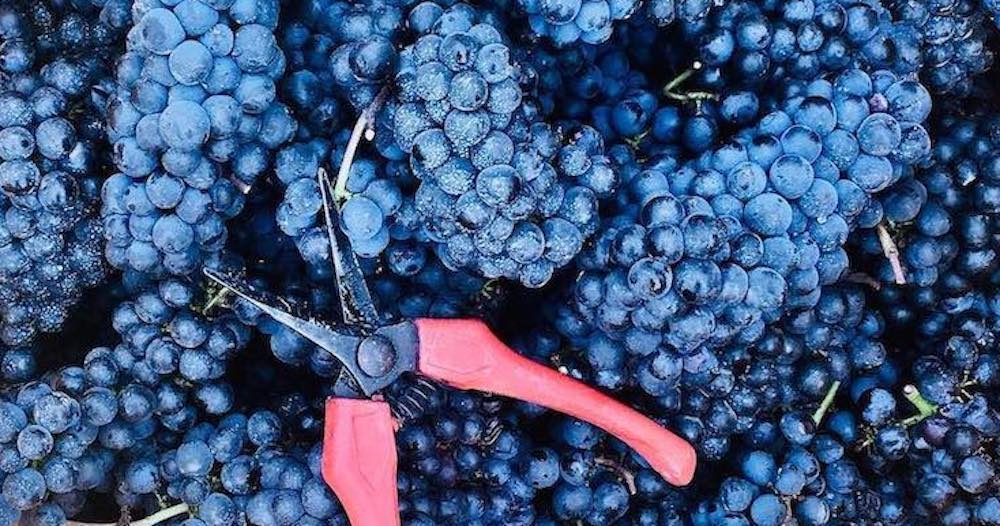
Note: For full report on Harvest 2023, go here.
Once the smoke cleared (and we mean that literally!), the harvest in all regions of Ontario was gifted a vintage-saving autumn that had winemakers excited for the wines that will be made in 2023.
As Domaine Queylus winemaker Mason explained, the 2023 harvest season needed divine intervention after a brutal summer that saw far too many gloomy, rainy, smoke-filled skies from B.C. forest fires. Ripening was behind by up to three weeks as the summer turned to fall. “I remember saying to friends, ‘we need a miracle: a completely dry September,’ ” Without that, there was the potential for a lot of rosé being made from Pinot Noir in 2023. The dry miracle of September was welcomed and had it not been for the sun and minimal precipitation, we would have experienced a different harvest — with all varietals.”
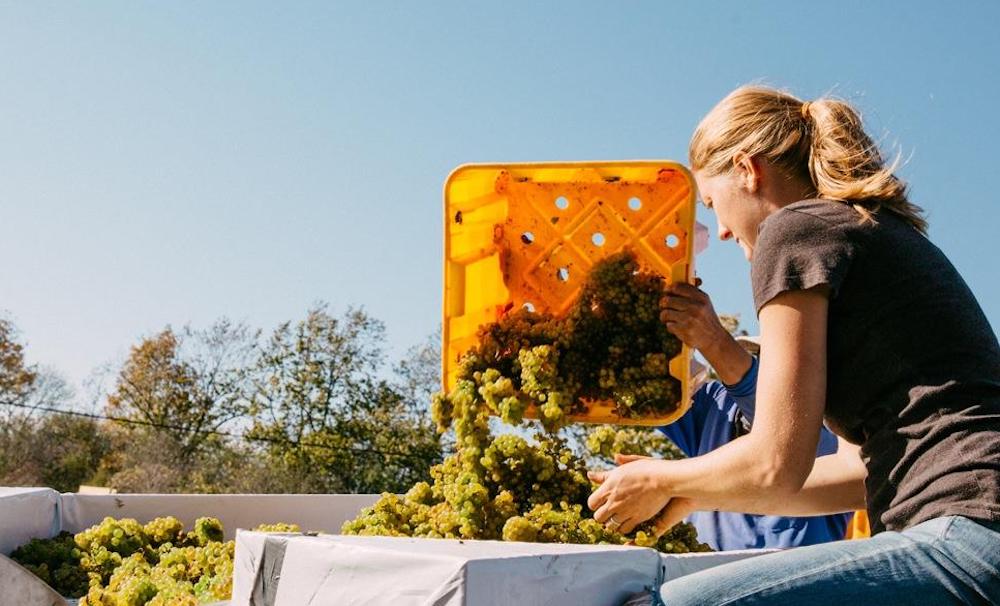
A few winemakers conjured up a famous Dickens’ quote to describe the growing season. “It was the best of times; it was the worst of times,” said Mackenzie Brisbois (above), the winemaker at Trail Estate in Prince Edward County winery. “We had a later spring frost in Prince Edward County and some of our earlier budding varieties showed slight damage. The summer months were challenging with plenty of rain and humidity, but the vines seemed to come out the other side flourishing. The fall was lovely and warm. We had good yields and exceptional flavours and celebrated our Chardonnay and Pinot Noir pick as the harvest full moon rose over our table of volunteer pickers.” Brisbois called it “one of my favourite harvests and I’m excited about the wines in barrel — plenty of complexity, texture, and beautiful flavours.”
Vineland Estates winemaker Brian Schmidt admitted that the 2023 harvest was anything but a smooth journey. “The fruit from 2023 demanded patience, hard work, and precision timing, and finally we tossed into the mix a healthy dose of good luck.
The fruit has now evolved into its higher form and these wines are a reminder that Mother Nature is ultimately the winemaker and we who call ourselves winemakers are just interpreters hoping to translate the story of each vintage into your glass.”
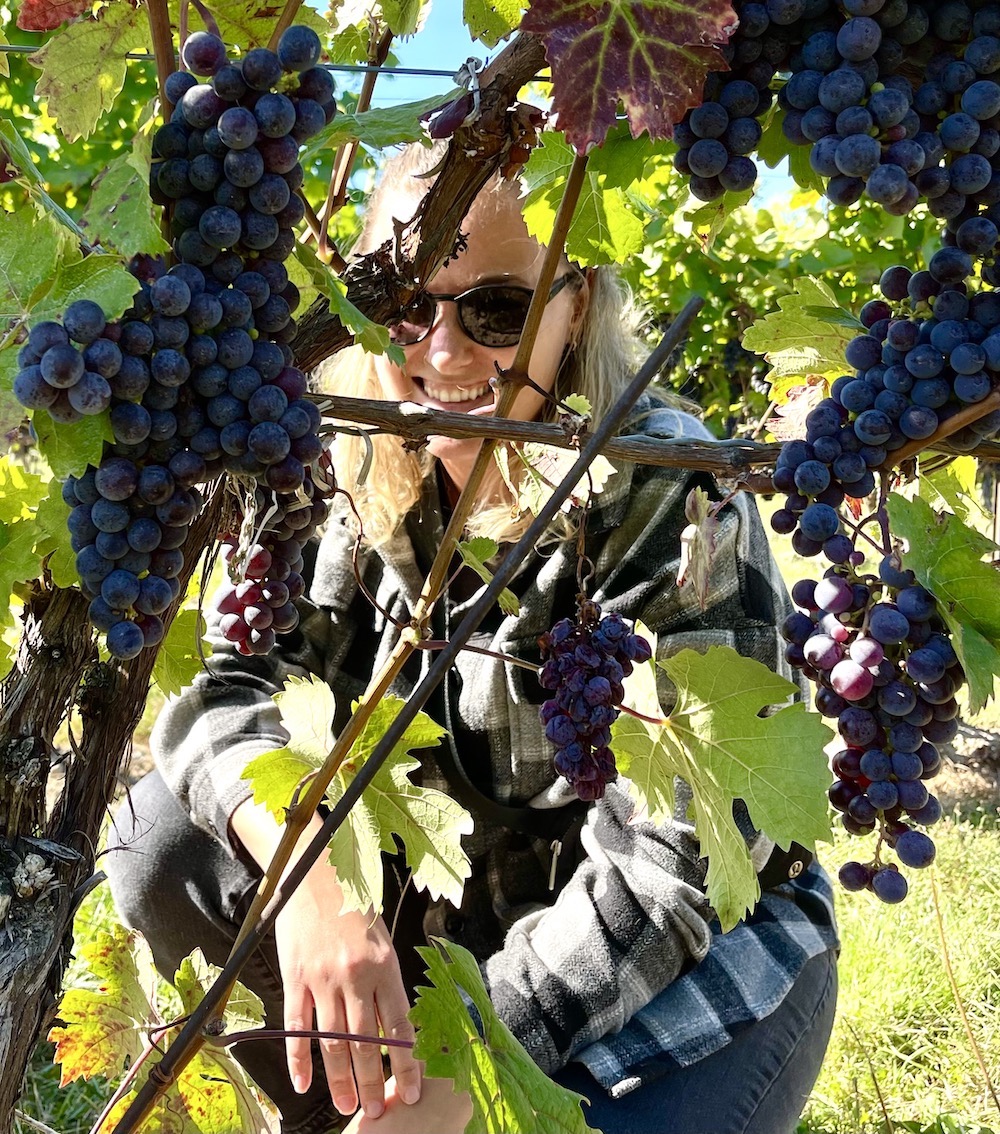
To be simplistic about the growing season in Niagara, spring was ideal, summer was a wet and soggy disaster, and then fall strutted in, boldly said ‘hold my beer,’ and allowed growers and winemakers to hang their fruit long enough to achieve phenolic ripeness well into November.
Debbie Zimmerman, CEO of the Grape Growers of Ontario, said that “despite the winter damage of 2021-2022, the grape yield and quality in 2023 was high. Overall, 75,727 tonnes were harvested with a $113.5 million farm gate value.”
Winemakers and growers harvested grapes will into November to take advantage of the warmth and to achieve phenolic ripeness. “Luckily, the weather held and was relatively mild and dry across all Ontario wine appellations,” VQA noted. By Nov. 15, the customary deadline for late harvest and icewine registration, many wineries were still actively harvesting grapes for table wine, trying to catch up from a season that behind was two-three weeks behind a normal year.
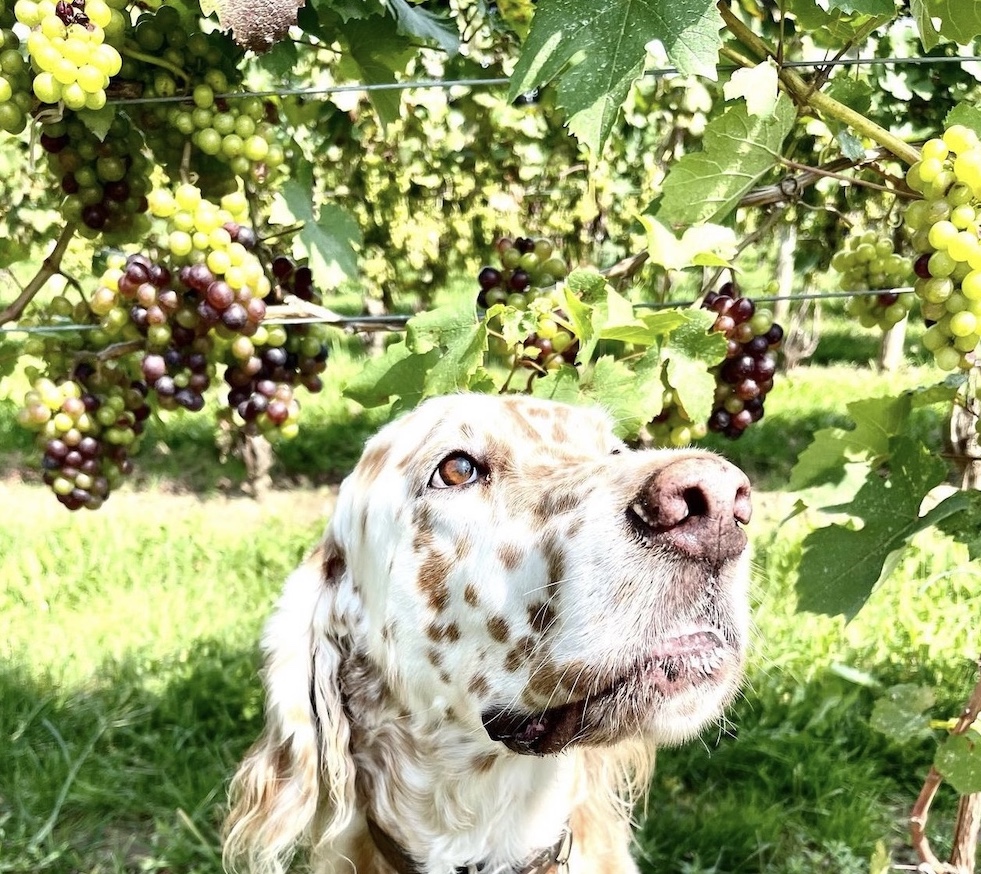
“Patience and not overcropping were key to success,” said Ann Sperling, consulting winemaker/viticulturist at Lailey Winery, Stonebridge Estate Vineyard, and Dobbin Estate Winery. “Using all tactics such as green harvesting, hand harvesting with selection and selection on sorting tables were employed. Careful winemaking has resulted in lovely bold wines with good colour, body and texture including active tannins in reds for longevity.”
Even notoriously early harvesters, such as Flat Rock Cellars on the Twenty Mile Bench, found themselves picking grapes late into the year. “In the end, our Pinot Noir, Chardonnay, and Riesling came in a little later than usual but at optimal ripeness and balance,” said owner Ed Madronich. “As a result of the slow maturation process and extended hangtime, we were able to achieve greater phenolic complexity than any vintage I’ve seen previously. The flavours and depth of the wines will be exceptional for Pinot Noir and Chardonnay. The Rieslings are vibrant and aromatically intense. I’m very excited about the vintage.”
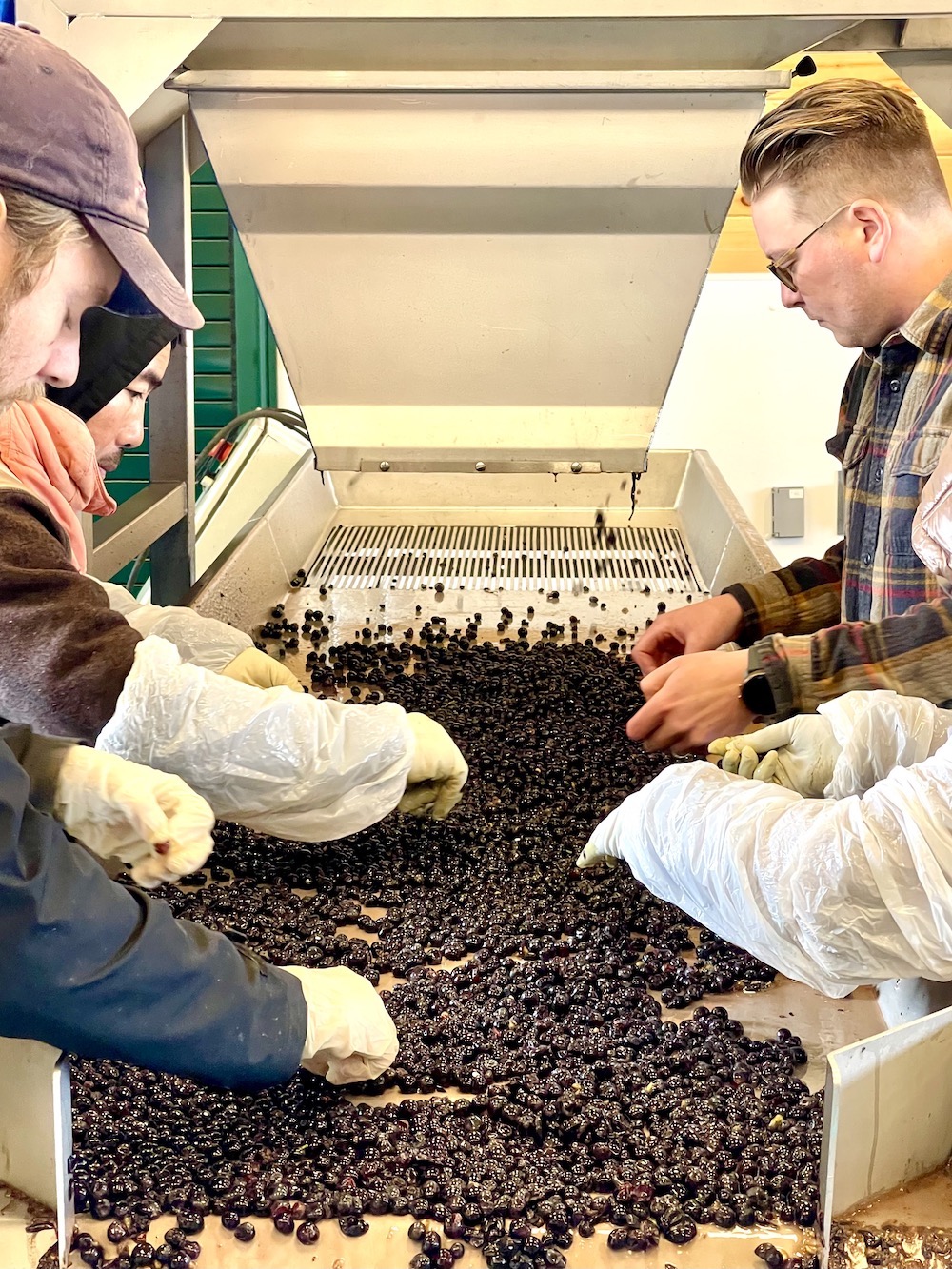
Harald Thiel, proprietor at Hidden Bench on the Beamsville Bench said this about the 2023 vintage: “I see the wines from 2023 landing somewhere in between the delicate, acid driven wines of 2019 and the ripe, structured wines of 2022.”
We have been publishing this Ontario vintage chart for 15 years on Wines in Niagara. Our goal is to keep it updated, relevant and ever evolving as we keep tasting back vintages and new wines. Tweaking of descriptions, and even ratings, have occurred over time as we taste more vintage wines and, of course, the drinking window, not an exact science, is in constant flux.
New to the chart is a “tentative” rating for 2023, a more informed review of the 2022 vintage and updates on all the other vintages (mainly in the drinking window) back to 1998.
As with any rating system, the score is less important than the description of the vintage. That is especially true when discussing a region such as Ontario where so many varieties of grapes are grown. What’s good for the Bordeaux varieties isn’t necessarily good for aromatic whites and early ripening red grapes in any given vintage. It is rare that, in terms of wine quality, a year is a total failure or a resounding success in Ontario, unlike vintages in say, Burgundy or Bordeaux. Please keep that in mind when reading our assessments.
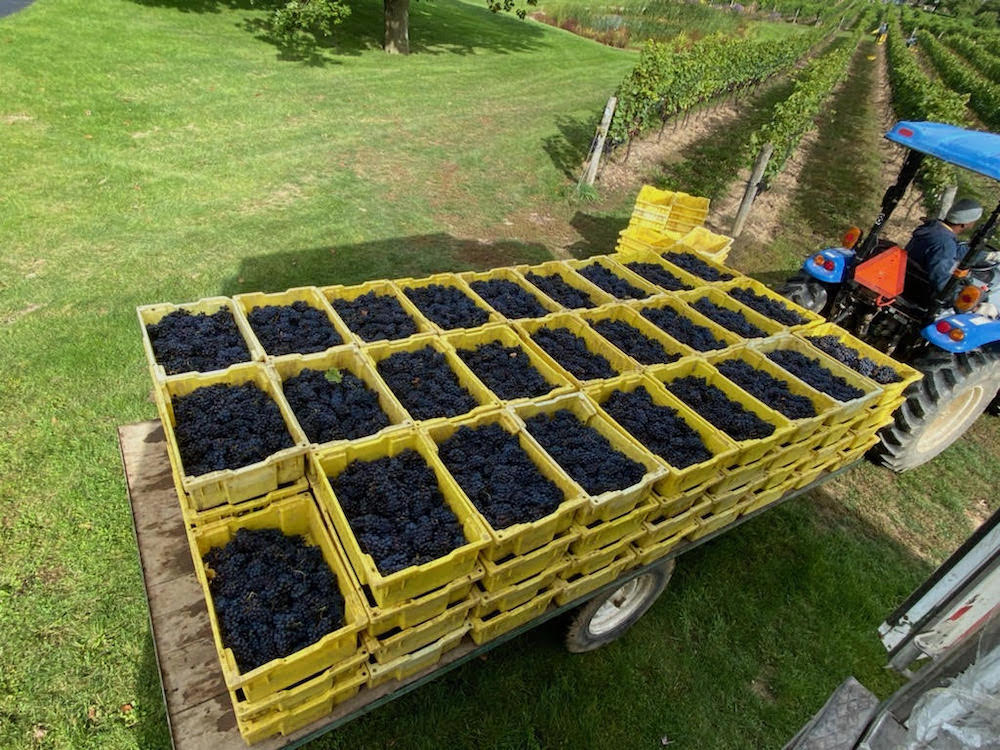
And, just to be clear, when cellaring your Ontario treasures, the drinking windows offered in the various vintage descriptions are likely understated because it’s far safer to offer you an earlier window rather than suggest that you drink something well past its prime. The long-lived vintages of 2020, 2016, 2012, 2010, 2007, 2002 and 1998 enjoyed spectacular, near perfect weather for grape growing and gave winemakers the raw ingredients to make stunning wines for many years to come, especially in the bolder style wines. And while I have found pleasure in tasting the 1998s recently, I know it will be hit and miss depending on cellar conditions, producer, cork choices and many other factors. If you find a great one, be thankful, but don’t expect every bottle from these vintages will impress you.
I sadly have very few 1998 bottles left in my cellar, but I do have a few from older vintages that I like to open every so often, mostly for reference, and I am often surprised at how long-lived Ontario wines can be. And I don’t mean they are merely drinkable; they can be so much better than when they were released.
The point is, as you cellar more and more of your favourite Ontario wines, let your palate be your guide. You are your own best barometer for knowing when to drink your wines depending on your tastes. These charts are just a guide to get you going.
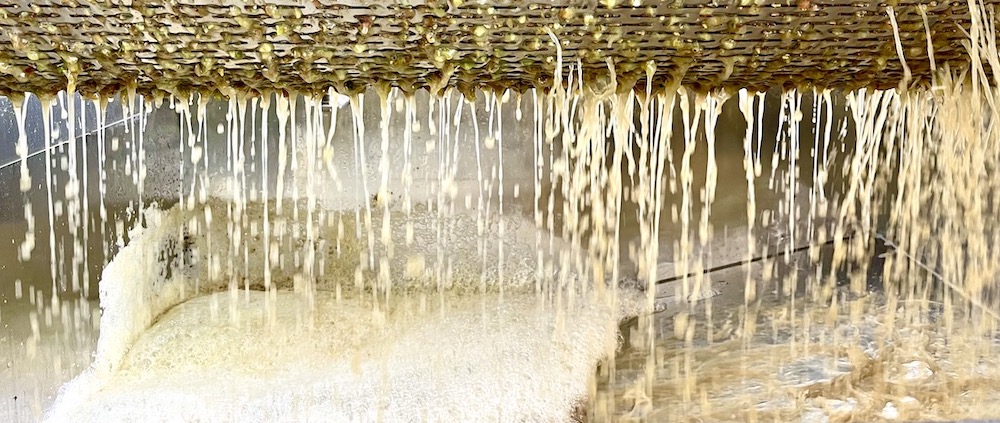
Ontario Wine Vintage charts going back to 1998
2023 ★★★★★★★★ (8 out of 10, tentative)
The vintage was remarkably saved by a dry, warm fall that provided relief from the wet, dreary, and smoke-filled summer that put harvest behind in most Ontario regions by up to three weeks. In the end, most varieties in all regions came out the other side in good shape and winemakers were breathing a sigh of relief. The crop was bountiful, so much so that it created the biggest surplus of grapes since 2008, resulting in 6,000 tonnes or so of fruit being cut to the ground without buyers.
Many winemakers praised the quality of Niagara stalwarts such as Pinot Noir, Gamay, Riesling, and Gamay, while others were impressed with Sauvignon Blanc, Pinot Gris and both Cabernet Franc and Merlot.
“I would say that the star of the vintage (so far, tasting in barrel) is probably Pinot Noir,” said winemaker/owner at Leaning Post Wines Ilya Senchuk. “We were able to pick beautiful, clean, fully ripe Pinot from four different single vineyards at 22-23 brix across all of them, with lovely ripeness and acidity. And they are in very different sub-appellations (St. David’s, Beamsville Bench and two in Lincoln Lakeshore). That rarely happens anywhere, and especially rarely in relatively humid Niagara.” Wine lovers should also watch for one on the best Sauvignon Blanc vintages in recent memory, superb Riesling, concentrated (but not jammy), structured reds such as Cabernet Franc, Merlot, and the fresher Gamays, along with elegant, ripe, finessed Chardonnays. Cabernet Sauvignon fans will find pleasure in those producers who thinned their crops and left the berries hang for as long as possible. It might take some diligence on the part of the consumer or stick to your favourites to find the best examples.
Another bright light will be the icewines. Those grapes benefited from a robust vintage following a few pared down harvests post-COVID. Winemakers were able to harvest frozen grapes at their leisure in mid-January at optimum brix.
Whites: Chardonnay, Riesling, and Sauvignon Blanc are the early favourites for the stars of the 2023 vintage. It’s hard to judge at this early stage, and I’ve only tasted a Sauvignon Blanc and rosé so far from 2023, but conditions were perfect for those grapes to develop vibrant fruit and juicy acidity from warm days and cool nights prior to harvest. That acidity should enable the Rieslings to age gracefully and provide pleasure for years to come and offer balance to the more structured Chardonnays as they age in oak barrels. In Lake Erie North Shore, the whites exhibit vibrant acidity, showcasing the bright fruit character and minerality inherent in the grapes. Riesling stands out from the crowd. In Prince Edward County, the superstar Chardonnay grape shows a harmonious balance of acidity, ripe fruits and distinct minerality.
Reds: Red wine lovers will appreciate the quality of both Pinot Noir and Cabernet Franc in 2023. The
extended growing season contributed to the development of ripe, concentrated primary fruit flavours and complexity in combination with firm tannins and finesse. Both varieties will provide cellaring opportunities once we see these wines a year or two down the road. Also watch for Gamay, Syrah and Merlot to shine in the short and long term, with tell-tale acidity for finesse and extended phenolic ripeness from the late fall “miracle” that took these varieties across the finish line. I anticipate this being a highly cellarable red vintage, with wines of ripe tannic structure, complexity, purity of fruit and laced with juicy acidity. The reds in Lake Erie North Shore showcase a rich fruit expression, well-integrated tannins, and a balanced structure. Cabernet Franc and Merlot have excelled in this vintage. In the County, Pinot Noir lovers will be delighted by the 2023 vintage, which displays the full spectrum of red fruit aromas balanced with juicy acidity. The extended ripening period has contributed to refined tannins and a velvety mouthfeel. This vintage has been particularly kind to Cabernet Franc, with the grapes achieving full phenolic ripeness.
2022 ★★★★★★★½ (7½ out of 10)
Don’t let the fact that the overall harvest in 2022 was slashed in half due a wet fall in 2021, followed by a brief but severe cold episode in the winter of 2022, guide your buying decisions as these wines arrive on store shelves. Make no doubt about it, there will are some very good wines from this vintage, but it will take astute buying prowess to get them — there just isn’t a lot of it around. Some wineries will have more wine than others, depending on how they were impacted by the deep freeze. Many winemakers who were able to harvest Sauvignon Blanc and Pinot Gris were impressed with the quality of the fruit, but there are tiny quantities of both out there. Riesling, as usual, is intense, concentrated and built to cellar. But it’s Chardonnay that seems to be the superstar on the white side, with one winemaker calling them “focused, fresh and concentrated.” On the red side, winemakers and growers are impressed with how well Cabernet Franc evolved over the harvest. One winemaker feels the reds made with Cab Franc will rival those made in the perfect 2020 vintage. High praise, indeed. What little Syrah that was harvested was of excellent quality and both Burgundian superstars in Niagara — Pinot Noir and Gamay — are touted as having great potential. We are just starting to see the 2022 reds, but there is plenty of upside to look forward to. As for icewine, it was one of the smallest harvests for icewine in decades. Only a handful of wineries even picked icewine due to the short crop of grapes. The quality looks good from what was harvested, it will just be rare to find a bottle of 2022 icewine.
Whites: Niagara winemakers were excited with the Chardonnay grapes that were harvested in 2022 along with the Riesling that wasn’t impacted by the wet(ish) fall. What little Sauvignon Blanc and Pinot Gris that was harvested is of high quality and sparkling grapes harvested early should provide exciting bubbles down the road. Prince Edward County winemakers, less impacted by the winter freeze, are excited by their superstar Chardonnay harvest. Lake Erie North Shore had a relatively normal season, so anticipate a good white vintage across the board. We haven’t seen enough of the 2022s to comment on aging windows, but suspect both Chardonnays and Rieslings can age well, while the fresher whites can be consumed upon purchase.
Reds: It’s shaping up to be another banner year for Cabernet Franc in Niagara and LENS. One Niagara winemaker feels 2022 eclipses 2020 for richness and complexity. The Burgundian grapes of Pinot Noir and Gamay also should perform at the top level, while Syrah, Merlot, and Cabernet Sauvignon, though hit the hardest by the cold and in short supply, should perform well once in bottle. LENS enjoyed an even season and will produce fine reds across the board and PEC winemakers are excited with the Pinot Noirs, though there are lower yields across the board. The biggest takeaway for 2022 for consumers is to not sleep on the vintage. There will be some sensational wines coming, but you will have to act fast if you want them in your cellar. Cellar all reds for now, we will have a better sense of the aging potential in next year’s report.
2021 ★★★★★★½ (6½ out of 10)
Our rating for 2021 is on the lower end for vintages in Ontario, but in line with 2014, 2011 and 2006, all of which were impacted by a wet fall or a chilly growing season. There is no getting around 2021 as a less desirable vintage, but it doesn’t mean many wineries weren’t able to work through the drastically wet fall during harvest, it just means consumers had to be vigilant when buying wines from 2021. There were (are) some nice ones out there, especially the early-ripening whites, sparkling wines, Gamays, some Pinots and Chardonnays, Cabernet Francs and even some Bordeaux varieties that came out on the other side of the rains intact. Some varieties, such as Riesling, got caught in the middle of the rain and breakdown of the grapes, causing some wineries to abandon making their top single-vineyard wines. It was a matter of picking decisions, that in some cases, meant picking before the rains while the grapes had not yet achieved high enough Brix (sugar content) required by VQA. 2021 is a vintage that tested the skill of winemakers in the field and the decisions they made on the fly will determine the quality of their wines. Consumers must make buying decisions based on those producers they trust and taste for themselves before purchasing. There will be some very fine wines, but unlike 2020, where everything seemed to work out, you might want to be more selective. As for icewine, because the harvest was smaller and sales of Canada’s signature wine have plummeted due to COVID, pre-registration was up from last year, but still far off pre-COVID numbers.
Whites: Drink Pinot Gris and Sauvignon Blancs, keep holding Chardonnays and Rieslings (to 2027). The rosés and early white wine releases fared well and were good to go on release. Some Rieslings (those picked before the rain) from top producers we have tasted are good to excellent as are the Pinot Grigios (Gris), Sauvignon Blancs and Chardonnays (again, pre-rain), plus the sparkling wines. Prince Edward County winemakers are happy with their Chardonnays grown in the County. We have tasted a fair number of white wines to date and feel these are early drinking wines, except for Chardonnay and Rieslings, which both have potential to age.
Reds: Gamays, Cabernet Francs and Pinot Noirs, not impacted by the rain, are the superstars on the red side of things. The other Bordeaux varieties of Merlot and Cabernet Sauvignon will depend on how they fared through all the wetness and disease pressure. The jury is out on these varieties. Most wineries released an avalanche of rosés made from red grapes, long gone now, and we suspect a lot of the bigger reds were declassified and blended into other red grapes. Prince Edward County reports good results from Pinot Noir. Drink Pinot Noirs now to 2027, and Bdx varieties to 2029.
2020 ★★★★★★★★★★ (10 out of 10)
Yes, you read that correctly. The 10 out of 10 rating for 2020 is richly deserved. It was a perfect vintage in Ontario. In the full vintage report published in 2021, 30 winemakers said they were confident that 2020 was the best they have seen in their winemaking careers in Ontario. There are few comparables. Yes, it was hot like 1998, 2002, 2007, 2010, 2012 and 2016, but 2020 was different; it was more favourable to all varieties across the board. It is the rarest of vintages when all grapes in Ontario (if picked at the right time) reach phenolic ripeness and maintain the acidity needed for balance, but, by all accounts, 2020, had both of those key ingredients as well as ripe tannins that will provide the structure and longevity in the red wines and offer complexity, elegance, body and freshness in the white wines across the board. While there were minor issues with early frost outside of Niagara and a crop 20% below normal levels across the board, by harvest the grapes benefited from ideal hang time, phenolic ripeness and each varietal was picked in optimum succession from beginning to end. It was a stress-free harvest and the one bright spot in an otherwise horrid year of COVID. Every winery we talked to bottled their top reserve reds, single-vineyard Pinot Noirs and Chardonnays. This is a vintage to buy and cellar. As for icewine, because the harvest was smaller and sales of Canada’s signature wine have plummeted due to COVID, very little was made in 2020, but what was made should be sensational. As Rosehall Run winemaker Dan Sullivan said at the time: “When the 2020 Ontario wines start being released run, don’t walk, to your nearest tasting room or online winery store and buy as much as your wallet can handle. Good fortune awaits the astute.” Sage advice, to be sure. We are still seeing 2020 reds being released in 2024, but most of the top wineries have released their best reds by now. Go get them!
Whites: Hold or drink Chardonnays (to 2028), Rieslings (to 2028, top wines longer), and drink Sauvignon Blancs and Pinot Gris. The whites have lived up to their predictions — fruit-packed, elegant, fresh, and lively. The Rieslings, Chardonnays and Sauvignon Blancs are showing much more wonderful concentration and complexity than previous vintages and are candidates for the cellar. You can safely wait on all of these but consider drinking the Sauvignon Blancs. Riesling and Chards can cellar to 2028, or drink now.
Reds: Hold Bordeaux varieties, blends and appassimento styles to 2030, drink or hold Gamays (especially more structured examples to 2026), drink or hold Pinot Noirs (to 2028), drink or hold Syrah (to 2027). The reds from 2020 are living up to the hype. Concentrated Bdx blends, rich and textured Pinots, up-front Gamays and some of the best Cab Francs to date in Niagara. The bigger reds are proving to be long-lasting, cellarable examples that will rival those from 1998, some of which are still going strong today. You will want to buy and hold the top examples. A dream vintage.
2019 ★★★★★★★ (7 out of 10)
You hear it a lot in Ontario — that was the wildest harvest ever! Well, in 2019, it truly was the craziest growing season in a very long time. A wet, cool spring put everything behind by about two weeks. Summer brought typical weather with normal temperatures across Ontario and the growing season got under way. Flowering occurred quickly as the grapevines accelerated their growing but struggled to make up for the late start. July was warm and sunny, punctuated by intense heat waves and high humidity. August was warm and intermittently stormy, leading into a comparatively quiet September, cool with some rain – but bringing decent conditions to finish off the summer and begin the harvest season. Early ripening grape varieties escaped the wild weather of late fall and especially an unusually early cold snap in mid-November. Yield reductions were common for many of the red varieties to ensure optimal ripeness, particularly for later maturing varieties. Harvest extended into early December, sometimes taking place in the snow. The first icewine grapes were picked on Nov. 12, well before a lot of the red Bordeaux varieties. White wines are the superstars of the vintage with crispness, ripe fruit, and finesse. Early ripening reds such as Pinot Noir are proving to be beautiful, built in the vein of the 2009s. The fuller-bodied reds will depend on the winery, winemaker and picking decisions (and, perhaps, technology). One thing is certain, there was no lack of freshness in Ontario wines from 2019.
Whites: Drink or hold aromatic whites (can hold Rieslings until 2025), drink or hold Chardonnay (2027).
Reds: Drink Gamays, hold Pinots another year or so, hold Bordeaux varietals a couple of years or top examples to 2027+.
2018 ★★★★★★★★ (8 out of 10)
Having now tasted most of the 2018 reds and whites, I have upgraded the overall score on the vintage to 8 out 10 stars last year. These are wines with freshness, depth and complexity, generally speaking. It was an ideal summer; hot, dry and long, sunny days. Everything was ahead on the ripening front, and it appeared to be another 2016 or 2012. But heavy rain and thundershowers mid-harvest turned the vintage on its ear and left many growers and winemakers with tough decisions to make in the vineyard (not to mention being dog tired). In some cases, it was a choice between saving one variety over another. The quality of the wines entirely depends on what decisions were made — not only in the vineyard but also in the winery. Most wines made with grapes harvested before the rains began are exceptional. Those wines made with grapes harvested after the rains began must viewed through a different lens and assessed on a wine-by-wine basis. Winemakers feel the wines they have are of good quality. The wines are tasting better than I anticipated, though there are low yields in many varieties.
Whites: Drink aromatic whites, including Rieslings, drink or hold Chardonnay for a couple more years (2026).
Reds: Drink Gamays, hold Pinots, Bordeaux varietals (up to 2028).
2017 ★★★★★★★½ (7½ out of 10)
All summer long it looked grim for the 2017 grape harvest in Ontario with cool, wet weather and the odd hailstorm thrown in very good measure. Then Sept. 1 rolled around, bringing extended heat and sunshine for one of the nicest falls on record and one of the latest harvests on record. The extra hang time for the grapes provided some needed ripening (in some cases right into December) and turned a potentially disastrous vintage into a good one. It was also a record season in terms of tonnes of grapes harvested. It resulted in excellent quality for aromatic white wines and good to excellent results for Pinot Noir, Gamay and Cabernet Franc. A few wineries declassified their top Bordeaux-varietal-based red grapes (so watch for the lower tiered reds to benefit from those grapes). As the whites and some reds were released, I was impressed with the quality. It would appear Ontario fully recovered from the back-to-back winter-kill years of 2014-2015.
Whites: Drink aromatic whites (can hold Rieslings up to 2026), drink or hold Chardonnay (2026.
Reds: Drink Gamays, hold or drink Pinots (to 2026), hold or drink Bordeaux varietals (2027).
2016 ★★★★★★★★★½ (9½ out of 10)
Winter in 2016 was mild and drama-free for grape growers in Ontario. By mid-May, the vintage settled into a sustained pattern of much drier and slightly warmer than normal. Drought in some areas was a concern in some parts of Ontario. The hot, dry conditions prevailed throughout August, with lots of sunshine and just enough rain to keep drought conditions from becoming too severe. Targeted irrigation was required to sustain the young vines planted to fill in sporadic damage from the cold 2014 and 2015 winters. Weather conditions were very similar in all appellations except for a short but major rain event in Lake Erie North Shore in September. In all, the growing season presented outstanding opportunities for grape quality across Ontario. Harvest was early in all regions for all varietals and was stress-free with dry conditions and limited disease pressures. It was the perfect recipe to provide an excellent vintage. Virtually all grape varieties performed well in 2016 and were picked in pristine condition. This was a year to buy and hold those bigger red wines (Bordeaux varietals, Syrah, etc.) that will age gracefully for 10 years or more. The Chardonnays are generally more robust than in cooler years and Pinot Noirs more complex. Rieslings will be riper and have immediate appeal. Across the board, this is a great vintage along the lines of 2012, 2010 and 2007 and a good bounce back from 2014-2015, even if the tonnage was not quite back to normal.
Whites: Drink Rieslings, Pinot Gris, Sauvignon Blancs; start drinking Chardonnays but some can hold for a year or two the top single vineyard examples if you prefer tertiary notes, otherwise drink up.
Reds: Drink Gamays, hold Pinots until 2025 or drink, hold on to bigger reds (save some for extended cellaring, up to 2028, maybe longer). This is a breakout year for appassimento-style reds, hold for a little longer (up to 2026).
2015 ★★★★★★★ (7 out of 10)
This was the second half of two brutal winters that caused a great deal of hardship and soul searching for winemakers and grape growers in Ontario. Record-breaking cold in the winter of 2015 was not what was needed after the horrible conditions of 2014. Many acres of grapes needed to be replanted and wineries had to make tough decisions of what not to plant in their terroir. The summer growing season brought good conditions with few major storms and sunny warm weather in all appellations. Niagara was slightly drier than Prince Edward County and Lake Erie North Shore. September weather settled nicely into warm beautiful conditions for the start of harvest and, except for some rainy periods in October, fall weather was favourable. Harvest conditions were excellent and good weather prevailed for much of the harvest period. Overall, grape production across the province was moderately less than normal but slightly more than 2014 when tonnes harvested were substantially less than previous years. Cold temperatures in January and February resulted in markedly reduced crop yields in Lake Erie North Shore, and less than full production in Niagara Peninsula and Prince Edward County. Tender grape varieties were in short supply. The irony of the vintage, devastating winter kill aside, is that it all averaged out by harvest and created conditions that allowed Ontario’s classic varieties — Riesling, Cabernet Franc, Pinot Noir and Chardonnay — to show well. Look for good concentration of flavours for the later ripening varieties that profited from the warm, dry summer and fall. In all, 2015 wines fared much better than 2014 wines, despite both vintages suffering through some of the most severe winter conditions seen in Ontario.
Whites: Time to drink up the Rieslings, Chardonnays and the rest of the whites from 2015.
Reds: Drink Pinot Noirs, Gamays and Cabernet Francs, and most of the reds in your cellar (top examples with a reputation for longevity can cellar until 2026 or so). Syrah should be consumed now.
2014 ★★★★★★ (6 out of 10)
The year was highlighted by a brutal winter that ultimately caused wide-spread bud damage leading to vine death in several varieties including (but not limited to) Syrah, Merlot, Semillon and Sauvignon Blanc. Couple that with a cooler year that always seemed a couple of weeks behind, varieties such as Cabernet Sauvignon and Cabernet Franc were tested. It is not a year for big red blends, but, on the bright side, the early-ripening Riesling, Chardonnay, Pinot Noir and Gamay enjoyed a very nice harvest and should provided some decent wines from the vintage. Savvy shoppers looked for de-classified reds from wineries with a trickle-down portfolio, good to excellent Riesling, Pinots, Chards and Gamays. I have spoken to many winemakers who did not make their top red blends in 2014 and many others who replanted their damaged and dead vines with varietals more suited to all weather conditions in Ontario. Wines from Prince Edward County weren’t hit as hard as Niagara and Lake Erie North Shore for two reasons: They bury their vines (or use geo-textiles), and they don’t grow that many varietals outside of Chardonnay and Pinot Noir.
Whites: Drink up.
Reds: Early drinking reds, for the most part, drink up. Check or drink bigger reds, but not built for the long haul.
2013 ★★★★★★★½ (7½ out of 10)
It was a late start to the season with every kind of weather imaginable tossed into the equation. Hot, cold, wet, dry … it was a rollercoaster ride, especially in Niagara. When it was all said and done, the season played to each region’s strengths — Chardonnay, Pinot Noir, Riesling and Cabernet Franc in Niagara, Pinot and Chard in Prince Edward County and early ripening varieties in Lake Erie North Shore. Most aromatic whites across the board showed promise in 2013. Quality is spotty for the other Bordeaux varieties, Cabernet Sauvignon and Merlot, and anything that was left out on the vine to ripen late. I would call it a typical vintage for Niagara that plays to the strengths of what the region does best but some of the top bottlings, especially in big reds, have been de-classified. It was a record crop both for table wines and icewine grapes, which came in handy for 2014 after a severe January cold snap caused wide-spread damage to vines, mostly in Niagara and Lake Erie North Shore.
Whites: Drink up.
Reds: These were for early consumption, for the most part.
2012 ★★★★★★★★★½ (9½ out of 10)
The mood in Niagara during the early harvest of 2012 was one of pure joy. Ripe fruit in pristine condition after a long, hot summer and early fall sent grape pickers into the vineyards in mid-August to harvest early ripening varieties. It was one of the earliest harvests on record for all varieties with only a slight hiccup during a brief rainy period in September. Reports from all regions in Ontario indicated a near-perfect season with the Bordeaux-style red grapes leading the way. Winemakers were also excited by the white grapes, especially Chardonnay, Riesling and Sauvignon Blanc, that all showed both juicy ripeness and natural acidity. The largest icewine crop was netted since 2007, an indication that Canada’s most famous export was set for a rebound in 2012. Since first writing this report I have now tasted most of the key 2012 reds from this vintage and have re-evaluated many of the whites. I have upgraded the rating from 9 stars to 9½ because I feel strongly that 2012 will prove to be the best vintage Ontario has ever encountered to date (that is, until 2020 came along). It’s not just the big red wines that are showing such promise, but all varieties across the board. Sort of unheard of until now.
Whites: Drink now or cellar to 2025, especially Riesling. Time to drink up those ripe Chardonnays.
Reds: Cellar to 2025 or more, Bordeaux blends 2026 to 2029 or beyond for top examples.
2011 ★★★★★★½ (6½ out of 10)
The extremely wet fall, during the peak of harvest for most varieties, meant careful buying strategies. Quality varied from winery to winery, and it depended a lot on picking decisions that were made. Pinot Noir, Gewürztraminer, Baco Noir and Cabernet Franc escaped the worst of the wet harvest, while Chardonnay was hardest hit. Late-harvest and icewine Rieslings were also affected by late-season rain. There were some very nice wines from 2011, however. Shop carefully. I have tried a few 2011s recently and downgraded my original rating by a half-point.
Whites: Drink now.
Reds: Drink now.
2010 ★★★★★★★★★ (9 out of 10)
Winemakers across Ontario have never been happier with a vintage (until 2020 and 2012 came along). The harvest started in the extreme heat of August and continued without concern through October. The red varieties, especially Cabernet Franc, Cabernet Sauvignon and Merlot, were some of the best grapes grown in Ontario and continue to gracefully. Even some of the whites show wonderful complexity, without being too flabby and soft. You can consume most Ontario wines from 2010 with confidence.
Whites: Drink now.
Reds: Cellar up to 2025 for Bordeaux varietal blends, or drink now. The very top bigger reds can stand a bit more cellaring, but try them from 2026 and beyond.
2009 ★★★★★★★ (7 out of 10)
In many ways, 2009 was like 2008. A cool, wet summer put the harvest up to 14 days behind for most red varieties, but a long, warm fall saved the vintage. Aromatic whites, particularly many exceptional Rieslings, are the stars of the vintage, along with the fabulous Pinot Noirs that are proving to be the best in recent memory. Bordeaux varieties had trouble ripening, especially Cabernet Sauvignon. Many wineries didn’t make their top red wines.
Whites: Drink now, but Rieslings still showing staying power (check on them).
Reds: Drink now.
2008 ★★★★★★★½ (7½ out of 10)
It was a wet growing season in Ontario, especially in Niagara and Prince Edward County, and grape ripening in all appellations was a challenge. The quality of this vintage depended entirely on vineyard management. Whites and cool-climate reds (Pinot Noir and Gamay) fared better than other varieties. The ’08 Rieslings and other white varieties are superb, but consumers should be selective with the reds. Complex Chardonnays are the stars of the vintage.
Whites: Drink now (or more if you like that nice vein of petrol in your Rieslings).
Reds: Drink now.
2007 ★★★★★★★★★½ (9½ out of 10)
The growing season across Ontario was just about perfect. The 2007 vintage was the best in Ontario’s history, up to this point. It was warm, dry and ideal for extended hang time on the vines. The 2007 whites showed beautiful concentration of flavour but lacked acidity and fell apart quickly. The red wines are proving extraordinary, especially with some age on them, from variety to variety. Look for rich, ripe, concentrated Bordeaux-style reds built to last. I tasted a Henry of Pelham Reserve Cabernet/Merlot 2007 recently and it blew me away. It still has the stuffing to another 5+ years.
Whites: Drink up.
Reds: Drink now, but many of the better examples continue to show nicely and will develop nicely for a few more years.
2006 ★★★★★★★ (7 out of 10)
Not as wet as 2008, but still humid and slightly cooler than normal. The mood was upbeat in Ontario as vines recovered from the terrible winter kill of 2005. There was plenty of sunshine in August, but a wet September meant wineries had to employ good vineyard selection. It was a decent year for Chardonnay, Riesling, Merlot, Gamay, Cabernet Franc and Pinot Noir, and a great year for icewines (that are aging nicely).
Whites: Drink now.
Reds: Drink now.
2005 ★★★★★★★ (7 out of 10)
This was a disastrous year. An extremely cold winter killed any hope for a healthy vintage, with more than half of the vintage wiped out. Many producers didn’t have enough wine to sell and suffered hefty financial losses. Both Lake Erie North Shore and Pelee Island fared better than Niagara. The irony of the vintage was that, even with a tiny crop, what was grown ended up being pretty good.
Whites: Drink now.
Reds: Drink now.
2004 ★★★★★★ (6 out of 10)
The 2004 vintage was a major relief for producers following the bad winter of 2003. Conditions improved immensely, and vines recovered from the previous winter kill. Some of the stars of the vintage included Riesling, Chardonnay, Pinot Noir, Cabernet Franc and Gamay. Tender varietals didn’t fare nearly as well.
Whites: Drink now.
Reds: Drink now.
2003 ★★★★★★★½ (7½ out of 10)
This vintage had it all: a horrible winter resulting in another short crop (a reduction of 45 per cent of all vinifera vines), the reappearance of the Asian lady beetle (which causes a nasty taint in wines) and, despite all of that, the emergence of some mighty fine whites. The rating for this vintage is really split between red and white wines: a 6.5 for red wines and an 8.5 for whites.
Whites: Drink now.
Reds: Drink now.
2002 ★★★★★★★★★ (9 out of 10)
A lot of winemakers rank this vintage up there with 2007 and 1998. This vintage was highlighted by severe drought conditions in all Ontario appellations for most of the summer. The resulting grapes ripened beautifully, with small, concentrated grapes, high sugar levels and tannins. A tasting of top 2002 cab-merlots in 2010 showed just how wonderful most of these reds have come along. Most are just now coming into balance and show wonderful fruit, spice and tannins.
Whites: Drink up.
Reds: Drink up, but some Bordeaux blends still holding on nicely, if you like mature wines. Check on them and decide based on your tolerance for aged wines.
1998 ★★★★★★★★★ (9 out of 10)
The best examples from this benchmark vintage are still showing beautifully. The whites have faded, but only just recently. This is considered by many to be the best vintage of the last century and the most significant vintage in Ontario’s history (2020 has eclipsed it, however). Recently opened bottles from this vintage are superb. The top Bordeaux-style reds continue to impress but all should be consumed now.
Whites: Drink up.
Reds: Drink up, but be aware that if you have any 1998s in your cellar, you just might be pleasantly surprised.






Comment here